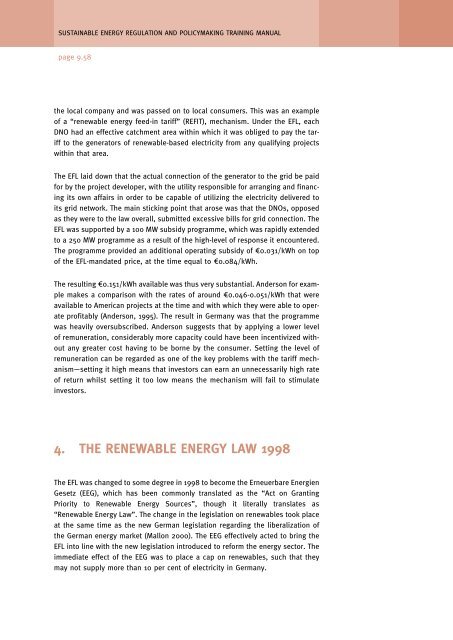Regulatory and policy options to encourage development of ...
Regulatory and policy options to encourage development of ...
Regulatory and policy options to encourage development of ...
- No tags were found...
Create successful ePaper yourself
Turn your PDF publications into a flip-book with our unique Google optimized e-Paper software.
SUSTAINABLE ENERGY REGULATION AND POLICYMAKING TRAINING MANUALpage 9.58the local company <strong>and</strong> was passed on <strong>to</strong> local consumers. This was an example<strong>of</strong> a “renewable energy feed-in tariff” (REFIT), mechanism. Under the EFL, eachDNO had an effective catchment area within which it was obliged <strong>to</strong> pay the tariff<strong>to</strong> the genera<strong>to</strong>rs <strong>of</strong> renewable-based electricity from any qualifying projectswithin that area.The EFL laid down that the actual connection <strong>of</strong> the genera<strong>to</strong>r <strong>to</strong> the grid be paidfor by the project developer, with the utility responsible for arranging <strong>and</strong> financingits own affairs in order <strong>to</strong> be capable <strong>of</strong> utilizing the electricity delivered <strong>to</strong>its grid network. The main sticking point that arose was that the DNOs, opposedas they were <strong>to</strong> the law overall, submitted excessive bills for grid connection. TheEFL was supported by a 100 MW subsidy programme, which was rapidly extended<strong>to</strong> a 250 MW programme as a result <strong>of</strong> the high-level <strong>of</strong> response it encountered.The programme provided an additional operating subsidy <strong>of</strong> €0.031/kWh on <strong>to</strong>p<strong>of</strong> the EFL-m<strong>and</strong>ated price, at the time equal <strong>to</strong> €0.084/kWh.The resulting €0.151/kWh available was thus very substantial. Anderson for examplemakes a comparison with the rates <strong>of</strong> around €0.046-0.051/kWh that wereavailable <strong>to</strong> American projects at the time <strong>and</strong> with which they were able <strong>to</strong> operatepr<strong>of</strong>itably (Anderson, 1995). The result in Germany was that the programmewas heavily oversubscribed. Anderson suggests that by applying a lower level<strong>of</strong> remuneration, considerably more capacity could have been incentivized withoutany greater cost having <strong>to</strong> be borne by the consumer. Setting the level <strong>of</strong>remuneration can be regarded as one <strong>of</strong> the key problems with the tariff mechanism—settingit high means that inves<strong>to</strong>rs can earn an unnecessarily high rate<strong>of</strong> return whilst setting it <strong>to</strong>o low means the mechanism will fail <strong>to</strong> stimulateinves<strong>to</strong>rs.4. THE RENEWABLE ENERGY LAW 1998The EFL was changed <strong>to</strong> some degree in 1998 <strong>to</strong> become the Erneuerbare EnergienGesetz (EEG), which has been commonly translated as the “Act on GrantingPriority <strong>to</strong> Renewable Energy Sources”, though it literally translates as“Renewable Energy Law”. The change in the legislation on renewables <strong>to</strong>ok placeat the same time as the new German legislation regarding the liberalization <strong>of</strong>the German energy market (Mallon 2000). The EEG effectively acted <strong>to</strong> bring theEFL in<strong>to</strong> line with the new legislation introduced <strong>to</strong> reform the energy sec<strong>to</strong>r. Theimmediate effect <strong>of</strong> the EEG was <strong>to</strong> place a cap on renewables, such that theymay not supply more than 10 per cent <strong>of</strong> electricity in Germany.










